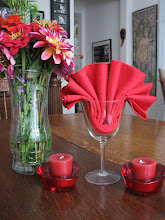I'm on the desert planet Dune, and there
is sand everywhere. Everything is
turning to sand, even my clothing. I can feel the gritty texture of my t-shirt
as it becomes sand, and I know I have to get it off me. I catapult out of bed and find myself
standing in front of my bathroom vanity, holding my night-shirt in my
hand.
Wait,
what just happened? I'm confused, the fever making it
difficult to distinguish dream from reality.
I put my night-shirt on again and go back to bed, where I find myself
again on the desert planet Dune.
Everything is turning to sand . . .
After
two or three repetitions of this sequence, when I keep waking up in my
bathroom, having taken off my shirt in my feverish delirium, I finally go to my
mother's
bedroom, where she is sleeping.
"Mummy?
I keep having bad dreams."
I'm not sure what I expect, but within
minutes she sets herself up to sleep in my bedroom, over my somewhat embarrassed
protests. She ignores my half-hearted
attempt to shoo her back to her own room and settles down to sleep on the
floor. I lay back in my bed, feeling
strangely comforted by her presence.
There are no more nightmares that night.
I have
other memories of middle-of-the-night mothering, although not all are so detailed. I remember waking up in the middle of the
night feeling alone and vulnerable. I
would go to my mother, and she was always able to make me feel better. These are probably the most canonical
mothering memories I have -- I'm
frightened and needy, and she is utterly dependable, capable, and
nurturing.
Asking for
nurturance is a moment of vulnerability, when we expose our need for
caring. Having to do so in the middle of
the night heightens the sense of vulnerability -- you are all alone in the dark and have to disturb someone's sleep to find comfort. How parents respond can have a profound
influence on our willingness to be open about our needs later in life. It is all too easy for a parent to be impatient
or shaming toward the child seeking care.
The parent may feel overwhelmed by the constant demands of caring for
children. Our society, too, has little
tolerance for neediness, preferring rugged independence (an unrealistic ideal,
to be sure), so parents may seek to "toughen
up" the child through shame. Shame and anger are poor teachers, though, as
they don't
eliminate our need for care, but make us unwilling to express that need openly
and have it met appropriately. Instead,
we wish others would psychically intuit our needs and nurture us, becoming
angry and depressed when this doesn't happen, berating ourselves for our
neediness and furious at others for their inability to meet our needs.
As a young
child, I had a periodic problem with bedwetting. I remember waking up after having an
accident, and going to my mother to let her know. Surely she didn't relish cleaning the bed
again, and wanted me to stop this night-time incontinence. But if so, I never sensed it. She never shamed me for these lapses, and she
was always patient about dealing with them.
I felt a certain shame, to be sure, for what I knew was bad and childish
behavior, but I never feared her reaction and I never doubted her willingness
to care for me, even in these most shameful moments. I am profoundly grateful for my mother's ability to provide care without ever
making me feel ashamed of my need for that care. I know that it is not always easy to offer
that kind of acceptance and I know how vital it is.
Asking for
nurturance is even harder as we grow up.
The sand nightmare, the result of a bout of tonsillitis, occurred when I
was in that awkward transition from child to adolescent. I wanted the mothering, but felt embarrassed
by my need for it. I'm glad my mother knew enough to ignore
my feeble protests and was willing to stay with me. She made it clear that it is ok to ask for care;
there is nothing shameful about needing nurturance, at any age.
Certainly
my mother was not the only one to nurture me.
I have been fortunate to have received love and care from my father,
siblings, other relatives, friends, and romantic partners over the years, all
of whom have helped me learn to give and receive nurturance. But my mother's
consistent patience and ready care stands out in my memory.
So to honor
my mother's
middle-of-the-night (and anytime-of-the-day) mothering, I give thanks for being
able to ask for a hug when I need one.
I give
thanks for being able to cry without feeling that it makes me weak.
I give
thanks for being able to tell someone that I'm
lonely and need a friend.
I give
thanks for being able to express my fears and anxieties so that others can
reassure and support me.
I give
thanks for being able to ask for reassurance from my colleagues about my
work.
I give
thanks for being able to listen to others when they are in distress and want nurturance
without judging them as lesser for their need.
I give
thanks that I can comfort others with patience and affection.
I may have
taken it for granted before now, but I am truly grateful for the ability to
give and receive care, without which my life and my relationships would be
significantly impoverished.
When we were children, we used to think that
when we were grown-up we would no longer be vulnerable. But to grow up is to
accept vulnerability. . . . To be alive is to be vulnerable.
~ Madeleine L'Engle
 |
| My father and mother traveling in Europe with me and my brother (1968) |

















